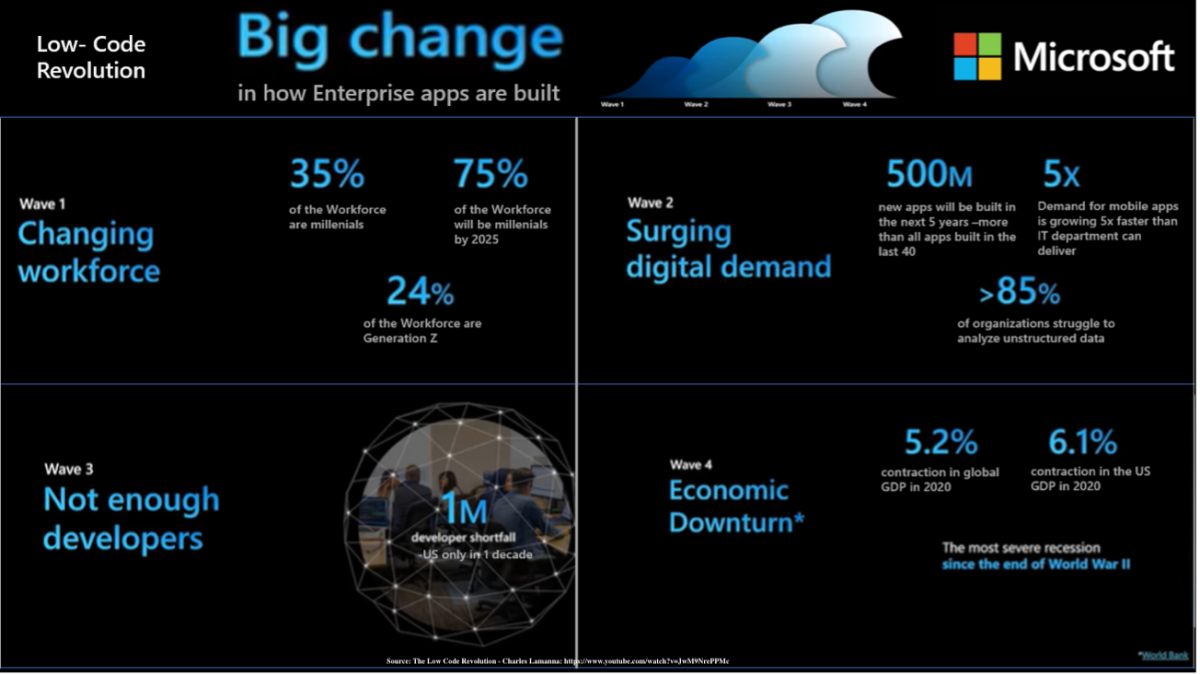There are many terms connected with FP&A, such as “unstructured analysis,” “predictive analytics,” and “machine learning". Often...
 While I was having a business meeting recently, I was asked to resume in simple terms: What is No-Code / Low-Code technology, and why should I consider it important for my business?
While I was having a business meeting recently, I was asked to resume in simple terms: What is No-Code / Low-Code technology, and why should I consider it important for my business?
I preferred to explain it in a simple, business logic and strait forward manner. Here it goes:
"It can be resumed most probably with some specific questions about the way you manage your business:
- Do you have current capabilities to oversee your entire company from your Smartphone, no matter where you are? Not only Whatsapp, business calls, and so on, but to have real time information about strategic KPI from your preference...
- Can you warranty that 100% of your organisational processes and I mean by that all of them (Order to Cash, Purchase to Pay, etc, etc), despite most probably very well written and trained to your team, are properly followed strictly as designed...
- Let us think for a minute that you can empower your team, since they are the ones who best know their jobs and how to improve them, and now have the capabilities to develop digital processes and applications for your business without direct dependency from IT department. Can you do that today...
- You have already heard about different best in class technologies such as Machine Learning, Artificial Intelligence, Business Analytics and a lot more. Then, are you able to merge all of them in only one platform / solution....
Well, I said... most probably you will answer NO to 3 out of 4 of this questions. Now imagine you can easily say YES to the four of them, and address a lot more advantages that can take your business to the next level. Will you consider knowing more about this?...."
Technology adoption is not a question of “if” but a question of “when”, before it is not late.
Interesting but, is this technology a good fit for FP&A. How can it help?
No-Code Technology
It is not latest news that No-Code / Low-Code technologies with their enormous capabilities to empower technology enthusiastics and practitioners, no matter size of the company or proffesional area where they develop their jobs, are gaining more and more adoption. You are not familiar with this terms? They can be resumed as follows:
No-Code is part of the No-Code / Low-Code technology movement which aims to enable business participants from different areas to design and implement organisational processes, and also their own applications with no or very limited software coding skills.
According to Research and Advisory firm Gartner, by 2025 about 65% of applications developments Worldwide will be based on No-Code / Low-Code technology. Why is that?
To explain it, I found a really interesting video from Microsoft Corporate VP Charles Lamanna, which most relevant information can be resumed like this:

No-Code and FP&A
Let us understand deeply now, how No-Code can help FP&A to increase Agility, cross-functional real collaboration and allow value creation.
- No-Code approach, no matter the platform / solution, cause there are a lot very good ones, basically allows to design, implement and share business processes (all of them) in a digital and agile manner, without any need of software coding skills.
- Most platforms act as “One unified solution” to not only merge different data sources and technologies but to enhance their synergic collaboration: Legacy Systems, Data Analytics, Machine Learning, Artificial Intelligence, Mailing activities, Company external sources of value added information, and more. How can they adress this: simple, via intuitive and powerful APIs and web integrations.
- Digital adoption is scaling really fast, more rapidly after Covid-19 Pandemic and precisely accelerating smartphones utilisation as the preferred devices. No-Code through their own cellphone apps can also help you get there.
A lot more advantages can be outlined here, however despite living in the Digital Era Budgeting and Forecasting activities within companies remain at their core almost the same:
- Mailing driven communications
- Excel based
- FP&A or Controlling departments “information pulled” approach
- Backs and forths, backs and forths…
Well, after more than 15 years experience within FP&A and Controlling departments in different organisations I could first hand observe, and usually had direct impact from the inefficiencies that this “core activities approach” generate.

So, imagine an scenario where enabled by No-Code technology the following can easily be perfomed:
- Design, share and agree to afterwards digitally implement company Budget and Forecasting processes within the organisation: information request initiation roles, approvers, supervision activities, and outcomes sharing.
- Fully integrate the platform with legacy systems, and develop precitive models with ML and AI technologies
- Upload all Budgets and Forecast documents into the same tool, track all processes interaction from different roles with full history capabilities. Very usefull here are enabled mailing and chats-based functionalities
- Have online business analytics, automatic comparisons, and explanatory fields directly referred to variances within the same tool (no need, if the case is chosen, for Powerpoint presentations)
- Have the possibility to perform the above mentioned activities, and a lot more, following your preference, having 100% freedom to design and implement your own agreed formal processes, and empower the selected roles to create dashboards, analytics, alerts, hole process automatic follow up, etc.; while not having a real dependency on your IT Department asigned times and resources capabilities, nor an external vendors solution improvement.
But this is not all, while your company´s Budgeting and Forecasting corporate processes continue to improve you can easily adapt the hole solution to it. Amazing no?
Welcome to No-Code technology and what it can do for FP&A
Subscribe to
FP&A Trends Digest

We will regularly update you on the latest trends and developments in FP&A. Take the opportunity to have articles written by finance thought leaders delivered directly to your inbox; watch compelling webinars; connect with like-minded professionals; and become a part of our global community.




